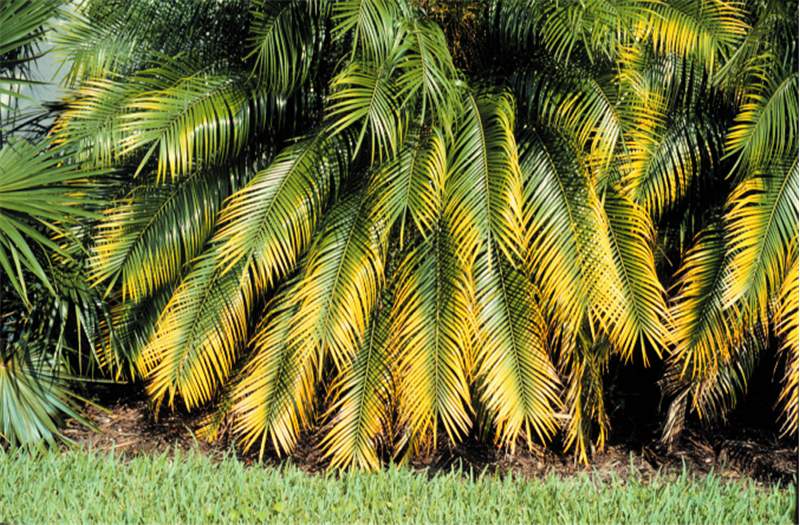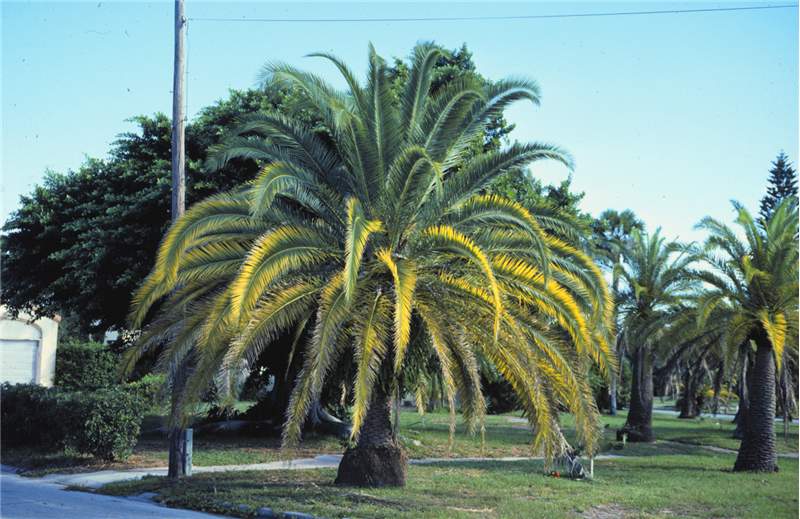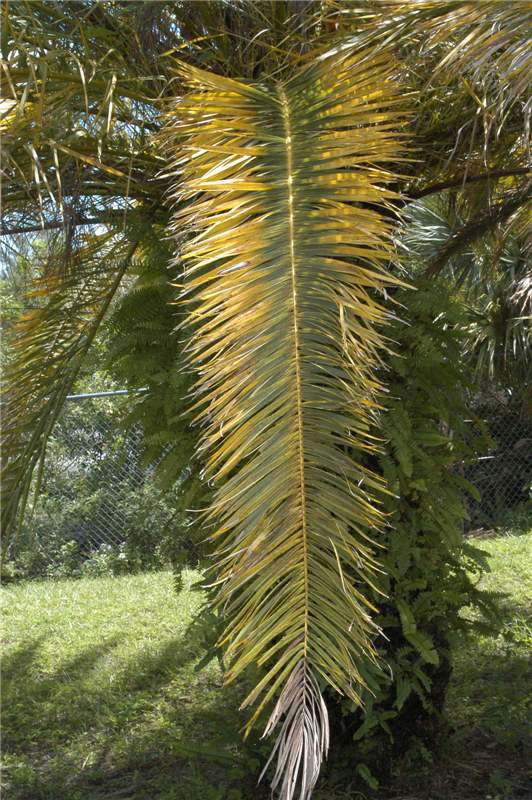Magnesium Deficiency
|
Figure 1. Magnesium deficiency symptoms on Phoenix roebelenii. Note the broad yellow bands along the outer margins of the leaves, but distinctly green central portions of the leaves. Photo by T.K. Broschat.
|
|
Figure 2. Magnesium and potassium deficiency symptoms on Phoenix canariensis. The broad yellow-banded mid canopy leaves show Mg deficiency, while the oldest leaves show leaflet tip necrosis (K deficiency). Photo by T.K. Broschat.
|
|
Figure 3. Older leaf of Phoenix canariensis showing Mg deficiency symptoms towards the leaf base and K deficiency symptoms towards the leaf tip. Photo by T.K. Broschat.
|
|
Figure 4. Magnesium-deficient older leaf of Livistona rotundifolia showing broad yellow band around entire leaf as well as a yellow band along margins of single leaf segments in upper left. Photo by T.K. Broschat.
|
Symptoms
Oldest leaves of magnesium (Mg)-deficient palms usually have broad chloroticchlorotic:
see chlorosis
bands along the margins with the central portion of the leaves remaining distinctly green (Fig. 1). In severe cases, only the rachisrachis:
the axis of a leaf beyond the petiole or an extension of the petiole into the leaf blade
and adjacent portions of the leaflets remain green on the oldest leaves, but younger leaves show progressively wider bands of green along the centers of leaves. In Phoenix spp., leafletleaflet:
divisions of pinnate leaves
tips on the oldest leaves may be necroticnecrotic:
see necrosis
, but this necrosisnecrosis:
dead tissue, usually desiccated and brown to gray in color
is due to potassium (K) deficiency superimposed on Mg-deficient leaves (Figs. 2 and 3). In palmate-leaved species with deeply dissected leaves, the chlorosischlorosis:
a loss of chlorophyll resulting in white, yellow, or orange leaf color
appears as broad yellow bands along the margins of individual leaflets (Fig. 4).
May be confused with
Magnesium deficiency symptoms differ from those of K deficiency in that symptom severity of K-deficient leaves increases gradually from base to tip of the older leaf, whereas Mg deficiency symptoms are distributed uniformly from base to tip of the leaf. Discoloration of K-deficient leaves is usually orange to bronze, shading gradually to green at the base of the leaf, whereas Mg-deficient leaves have distinctly green leaf centers and bright lemon yellow to orange (depending on the species) margins extending the entire length of the leaf. There is never any necrosisnecrosis:
dead tissue, usually desiccated and brown to gray in color
associated with Mg deficiency, whereas leafletleaflet:
divisions of pinnate leaves
necrosis is a common symptom on K-deficient palms. It is possible for a palm to show symptoms of both deficiencies on a single leaf.
Cause
Magnesium deficiency is caused by insufficient Mg in the soil. Magnesium is readily leached from sandy and other soils having little cation exchange capacity. High levels of nitrogen (N), potassium (K) or calcium (Ca) in the soil can also induce or exacerbate Mg deficiencies.
Occurrence
Magnesium deficiency is very common on highly leached soils in Florida, Hawaii, and other tropical areas. It can also occur in container-grown palms if dolomitic limestone has not been added to the substrate. Also, since palms may remain in a container for up to a year or longer, any added dolomite is usually exhausted after six months or so with Mg deficiency symptoms becoming visible as a result. Most species of palms are susceptible to some degree, but Phoenix canariensis is by far the most susceptible species to this disorder.






